
~~~~~~~~~~~~~~~~~~~~~~~~~~~~~~~~~~~~~~~~~~~
Live Earth Farm (Com)Post
9th Harvest Week, Season 12
May 28th - June 3rd, 2007
~~~~~~~~~~~~~~~~~~~~~~~~~~~~~~~~~~~~~~~~~~~
(click here for a pdf of the paper
version of this newsletter)
In this issue
--Greetings from Farmer Tom
--News from the Field
--More fascinating honeybee info
--Take action on the 2007 Farm Bill
--What's in the box this week
--Notes from Debbie's Kitchen
--Calendar
--Contact Information
" No occupation is so delightful to me as the culture
of the earth, and no culture comparable to that of the garden."
~ Thomas Jefferson
Greetings from Farmer Tom
~~~~~~~~~~~~~~~~~~~~~~~~~~~~~~~~~~~~~~~~~~~~~~~~
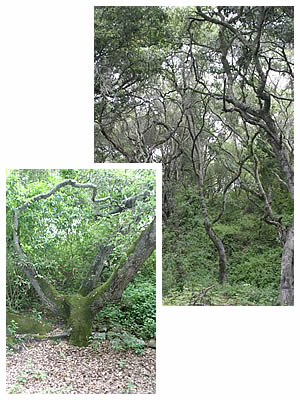 Most
of us enjoy getting away from our everyday hustle and retreating to a place
free from interruption, to catch our breath, calm down and find a moment of silence.
Here on the farm I retreat to our small forest sanctuary of Coast Live Oak where
I can cradle in the branches of an old oak tree.
Most
of us enjoy getting away from our everyday hustle and retreating to a place
free from interruption, to catch our breath, calm down and find a moment of silence.
Here on the farm I retreat to our small forest sanctuary of Coast Live Oak where
I can cradle in the branches of an old oak tree. 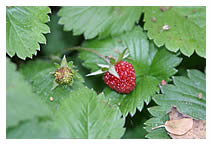 As
I entered the forest a few days ago, I noticed a patch of wild Alpine strawberries
growing in the understory, dotted with ripe little fruit. I was so excited to
be able to savor berries growing wild and not cultivated by any human hand or
machine. It reminded me of the wild ancestry that exists for each crop we grow
and how, over thousands of years, humans have selected the few plant families
that now serve as the basis of our diet. Today, it is hard to imagine how the
local Indian population survived solely by hunting and gathering to meet their
basic needs for food, medicine, shelter and clothes. None of the crops we currently
grow existed in this area before. The main plants once used as food sources were
acorns, buckeyes, Islay prunes, blackberries, and certain grass seeds. Even the
Alpine strawberry I savored beneath the canopy of Live Oak trees was originally
introduced from Europe. All the crops in our shares trace their wild ancestry
back to Europe, Asia, South America, and the Middle East. Most of us have lost
the plant knowledge that was once at the core of every human culture: knowledge
about how to grow, pick and use plants. I know I have been unsuccessful in passing
this knowledge on to my kids when I see how easily my son David, for his 13th
birthday party last week, gravitated towards the lure of today's fast-paced supermarket
world, choosing take-out pizza and ice cream cake over treats from the farm.
As
I entered the forest a few days ago, I noticed a patch of wild Alpine strawberries
growing in the understory, dotted with ripe little fruit. I was so excited to
be able to savor berries growing wild and not cultivated by any human hand or
machine. It reminded me of the wild ancestry that exists for each crop we grow
and how, over thousands of years, humans have selected the few plant families
that now serve as the basis of our diet. Today, it is hard to imagine how the
local Indian population survived solely by hunting and gathering to meet their
basic needs for food, medicine, shelter and clothes. None of the crops we currently
grow existed in this area before. The main plants once used as food sources were
acorns, buckeyes, Islay prunes, blackberries, and certain grass seeds. Even the
Alpine strawberry I savored beneath the canopy of Live Oak trees was originally
introduced from Europe. All the crops in our shares trace their wild ancestry
back to Europe, Asia, South America, and the Middle East. Most of us have lost
the plant knowledge that was once at the core of every human culture: knowledge
about how to grow, pick and use plants. I know I have been unsuccessful in passing
this knowledge on to my kids when I see how easily my son David, for his 13th
birthday party last week, gravitated towards the lure of today's fast-paced supermarket
world, choosing take-out pizza and ice cream cake over treats from the farm.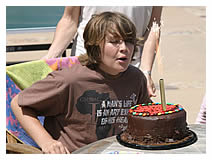 It's
not cool anymore to pick strawberries with his friends. So at the end of the
day, when he complained about feeling sick and feverish (surprise!), Dad wasn't
too worried or sympathetic. In the meantime, while David matures and faces the
challenging years of adolescence, I will protect and expand the few wilderness
spots here on the farm to encourage more habitat for beneficial insects, birds
and wildlife, and most importantly, to continue to have a place to retreat to
and search for our own long lost biological roots. Who knows... maybe one day
David will want to sit in his father’s
favorite oak tree, dreaming of ancestors and wild strawberries.
It's
not cool anymore to pick strawberries with his friends. So at the end of the
day, when he complained about feeling sick and feverish (surprise!), Dad wasn't
too worried or sympathetic. In the meantime, while David matures and faces the
challenging years of adolescence, I will protect and expand the few wilderness
spots here on the farm to encourage more habitat for beneficial insects, birds
and wildlife, and most importantly, to continue to have a place to retreat to
and search for our own long lost biological roots. Who knows... maybe one day
David will want to sit in his father’s
favorite oak tree, dreaming of ancestors and wild strawberries.<back to top>
News from the Field
~~~~~~~~~~~~~~~~~~~~~~~~~~~~~~~~~~~~~~~~~~~~~~~~
Garlic and onions are being harvested to dry and cure (see pictures below), and
we’ll
be cleaning the fennel field, putting the last of it into this week’s shares.
The beets you’re getting this week are from a new planting and will be
either the cylindrical Italian Forono or the dark read-leafed Bull’s Blood.
We’re
leaving the golden beets in the field a little longer so that they can size up
and so we can have some for everybody. Tomatoes are growing quickly and already
fruiting. Right now, as you can probably tell, we are experiencing a wonderful
bounty of strawberries. Many people have asked whether we open the farm for members
to pick their own. Although we don’t offer a typical ‘u-pick’ operation,
our first community gathering on June 23rd to celebrate the Summer Solstice may
be the best time for anyone interested to show up early and pick berries. Please
stay tuned to this newsletter for more information and directions as the date
draws near. This week’s Basil comes from Mariquita Farm, a partner in the
Two Small Farms CSA. Andy Griffin and Julia Wiley from Mariquita Farm are our
neighbors, living on their own farm right here in Watsonville. Although they
live nearby, most of their crops are grown on land in the warmer Hollister area,
hence the early basil you are getting this week – a teaser for the summer
crops to come!! The pear orchard is getting it's first watering and fruit are
starting to size up. The Pineapple Guavas are in full bloom too; we should have
a good year, especially with having Steve Demkowski’s bees pollinating
them.
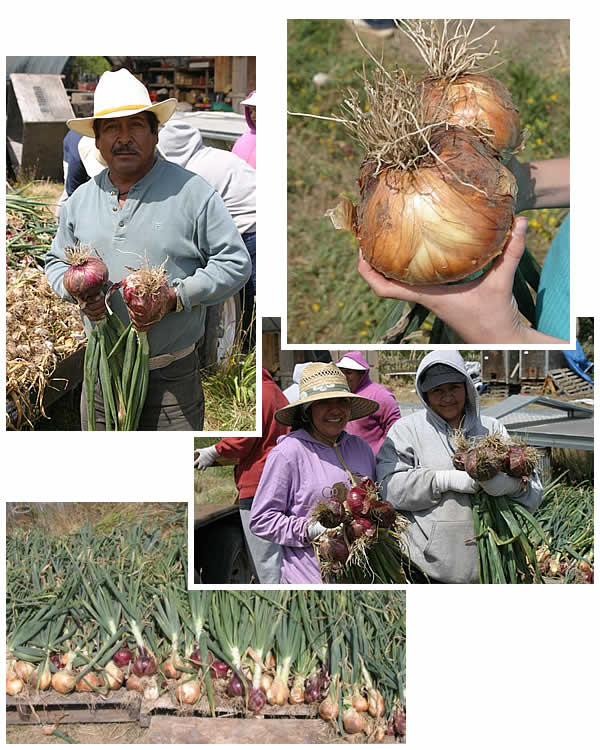
<back to top>
More fascinating honeybee info
~~~~~~~~~~~~~~~~~~~~~~~~~~~~~~~~~~~~~~~~~~~~~~~~
Speaking of bees, last week someone wrote the farm
with some very insightful questions about some odd bee behavior they
observed. I forwarded the questions on to Steve who copied me with his
replies, and the discussion was so enlightening I felt our members would
be interested in following along. – Debbie
Question posed by Jamilynn Willaman:
“I [was reading] a recent article in the Santa Cruz Sentinel about the
disappearing bees and was hoping you might be able to shed some light on why
we keep finding bees literally in the water. And, could this be one of the places
where the bees are disappearing to?
“I've been following the story of the disappearing bees and have noticed
bees by the water's edge for about three years now. (My son has been stung twice
walking barefoot and my husband once.) Tonight, on our one mile walk to Seascape
Resort, in Aptos, there were literally hundreds of bees by the surf's edge. Those
that were still alive were either on their backs or else crawling toward the
water. We collected about 15 of them in an empty bottle - if you would like them
we can send them to you. We would have collected more but they started attacking
each other in the bottle. We were pretty horrified, so we stopped.
“We have also encountered numerous bees at the surf's edge at Seabright
and Rio Del Mar beaches in Santa Cruz County.
“Please let me know if this info is relevant. I think honey bees by the
ocean surf is very odd. Is it?”
Steve’s reply:
“Hi Jamilynn and Debbie. Honey Bees need lots and lots of water to cool
their hive or water down the honey for their babies. They will use salt water
if the fresh water is not clean enough or close to their hive. The more bees
that are used to carry water (water girls) the less will be use to gather nectar
or pollen (foragers), which means less honey for the hive and for us.
“It is really important to have a clean water supply close to the hives.
This helps keep the bees out of our swimming pools. Once the honey bee has located
a water source it will not change to another even if you place water closer to
the hives...stubborn.
“At the Tilton Ranch in Morgan Hill our bees use the salt licks for the
cattle to get a little salt in their diet. I have also seen them taking up water
from wet soil to get their salt and mineral intake. This is also how they are
exposed to soil pesticides and herbicides on the yards and farms that use them.
“Honey bees react to fast motion, color and smell. On the wet bee thing:
never pick up a wet bee with a cloth or your bare hands. Wet bees automatically
sting, even if you are nice to them. Other than that they are safe to be around
when gathering water or nectar.
“The bees that attacked each other in the bottle were from different hives
and will fight to the death. They will gather nectar, pollen and water right
next to each other but put them in the same room... it's a perfume thing.”
Bee Happy and Safe,
Steve Demkowski
Steve the bee man
Jamilynn continues:
“Thank you very much for that information, Steve. I had no idea..! Absolutely
fascinating. Just one more thing, and then I'll drop it. A lot of the bees in
the wet sand were dead. Is this common as well? That' all. Thanks for your time!”
Steve replies:
“No it's not common. The waves may have washed over them while they were
taking up water, or a swarm may have wandered out over the water and the Queen
dropped out of the sky and the rest followed. Queen bees haven't flown since
their mating flight which could have been a year or two, or more. You can imagine
how out of shape she is on flying. That's why you see a ball of bees in a tree
or bush during the swarm season. The old Queen can only fly a couple of hundred
yards and then she has to rest. Then the rest of the bees festoon around her
until she catches her breath. The bees are in the best mood – full of honey – at
this time, and are easy to catch and make a new hive with. Some of the nuttier
beekeepers make a bee beard with them. A swarm from someone else's hive is a
beekeepers dream. Free bees! We all like "free bees." I wonder if that's
where the expression comes from [freebies]?
“There are about 4,000 bees to the pound, and the swarms these days only
get up to 3 to 5 pounds (12,000 to 20,000 bees). The bee swarm you saw pictures
of in last week’s Live Earth Farm newsletter was about 2 to 3 lbs.
“A swarm in May is worth a load of hay.
A swarm in June is worth a silver spoon.
A swam in July isn't worth a fly.
“Not my poem, but I like it. In California, a honeybee swarm in July can
still make it through winter... but not in Nebraska.
“Trying to stop bees from swarming is like trying to stop birds from laying
eggs. Bees swarm and bird lay eggs; it's an amazing event. In Europe when a swarm
comes to your yard it's a blessing; here, most folks call a pest control company
to kill them off.
Thank you for you interest in bees, don't stop now! Sounds like you may have "bee
fever" – for which there is no known cure!”
Hapbee Day,
Steve
Lastly, [this is Debbie again] if you’re still as fascinated
by this bee stuff as I am and want to learn more, read this article in
the Smithsonian magazine Steve forwarded to me [I read it and it is great – not
too long, an easy read]. It is an interview with May Berenbaum (entomologist
from Urbana, Illinois) about the honeybees disappearing; CCD. Steve summarizes: “One
of her theories is that ‘the honeybees know something we don’t and
they’re getting out.’ Another is that ‘visitors from another
planet have decided they were going to abduct the smartest organisms on Earth,
and they picked the honeybees!’” here’s the article: http://www.smithsonianmagazine.com/issues/2007/june/interview.php
As Steve would say, Bee seeing you...
<back to top>
Take action on the 2007 Farm Bill
~~~~~~~~~~~~~~~~~~~~~~~~~~~~~~~~~~~~~~~~~~~~~~~~
The Farm Bill now working its way through Congress has a huge impact on
the way this country grows its food (remember folks, it's only renewed every
5 years, so we’ll be stuck with whatever happens with this year’s
legislation for awhile). Our best chances for having any sway over its outcome
is to become informed and to take action. With issues like Global Warming and
Peak Oil nipping at our heels, this legislation is more important than ever.
Here are two links, if you’d like to follow this thread:
<> First, if you are new to the Farm Bill, read
this! It is an eloquent
explanation of how it works, written by Michael Pollan [I ran this in one of
our Winter newsletters]. This is eye-opening. Brings you up to speed fast.
<> Second, an email from the California Coalition for Food and Farming
offering specific ways you can take action to support Farm Bill legislation that
will in turn support healthy, affordable, local foods and family farms [click
here to read].
<back to top>
What's in the box this week
~~~~~~~~~~~~~~~~~~~~~~~~~~~~~~~~~~~~~~~~~~~~~~~~
(Content differences between Family and Small
Shares are underlined and italicized; items with a “+” in
Family Shares are more in quantity than in Small; anticipated quantities are
in parentheses. Sometimes the content of your share will differ from what's on
this list, but we do our best to give you an accurate projection. It's Mother
Nature that throws us the occasional curve ball!)
Family Share:
Basil (Mariquita Farm)
Beets (Forono or Bull’s blood)
Broccoli (from LEF, supplemented from Lakeside only if we don’t have enough)
Carrots
Fennel (3)
Garlic
Kale [red Russian] or Chard
Lettuce (Romaine and red oakleaf)
Red mustard greens
Summer squash (Lakeside/LEF)
Onions +
Tatsoi
Strawberries (2 bskts)
Small Share:
Basil (Mariquita Farm)
Beets (Forono or Bull’s blood)
Chinese cabbage OR broccoli (broccoli from LEF, supplemented from Lakeside only
if we don’t have enough)
Fennel (2)
Lettuce (Romaine OR red oakleaf)
Red mustard greens
Onions
Tatsoi
Strawberries (2 bskts!)
Extra Fruit Option:
4 baskets of strawberries
"Strawberry Bounty" Option:
5 baskets of strawberries!
<back to top>
Notes from Debbie's Kitchen
~~~~~~~~~~~~~~~~~~~~~~~~~~~~~~~~~~~~~~~~~~~~~~~~
(Click
here to go to my extensive
recipe database, spanning nearly 10 years of CSA recipes and alphabetized
by key ingredient. Includes photos of most farm veggies; helpful for
ID-ing things in your box!)
Growing your own fresh herbs
I have finally planted my own herb garden! I’ve lived here over 20 years
and I can’t believe it took me this long (I’ve wanted to do it since
forever). Other than the rosemary bush I planted a couple years ago, I’ve
mostly used dried herbs, with the occasional fresh herbs from the farm. Yet I’ve
always mooned over the idea of having fresh herbs growing right out my back door.
I mean, how much more fresh and local can you get? Now that I’ve done it – it
was so easy! – I thought I’d encourage you all to NOT wait forever
like I did and plant your own now. Although this isn’t a ‘recipe’ per
se, I see this as a synergistic adjunct to getting a CSA share: what better way
to season your fresh farm veggies than with your own fresh herbs?
If you don’t have a yard, you can grow them in pots on a sunny windowsill
(I’ll get there in a moment).
Now I’m not a farmer (or even much of a gardener), but having worked for
the farm over 6 years now (and been a member for 11!), I am no doubt learning
by osmosis about the right way to do these things. And if I’ve learned
nothing else, what I have learned is that it’s all about the
soil.
Here’s what I did: I used these old chimney blocks (from when we took down
our chimney a couple years ago) as planting containers outside. They’re
in a part of the yard that gets decent sun (photos below were taken in the morning,
when they were still mostly shaded by nearby trees). I filled them with a mixture
roughly 50-50 of soil from my yard and organic compost from the store (there’s
an OSH [Orchard Supply Hardware store] near my home, but any gardening supply
place worth its mettle should carry it. If they don’t carry organic compost,
talk to management and convince them to change their ways). I also got little
starter pots of herbs from the same place; they’re only a couple dollars
each – as much as you might spend on a jar of dried herbs, so what
the hey, no brainer! The only other thing I bought was redwood mulch. That’s
the second thing I’ve learned (I’m still learning!): mulch deeply
and mulch often! Well, mulch after you first plant things, anyway. A nice thick
layer of mulch on top of the soil around your plants helps hold the moisture
in and the plants thrive. That’s it really; plant the herbs in good soil
in a sunny spot, in healthy organic soil, mulch well, water periodically, and
occasionally feed. I plan to use a little diluted juice from my worm composter
to feed my herbs. What did I plant? Sage, chives, thyme, dill and marjoram. I
already had the rosemary, and we get basil, cilantro and parsley periodically
in our CSA shares. But hey, grow whatever floats your boat! And by planting the
already started herbs, I was able to snip and use them judiciously within a week
of planting. Now, a little over a month later, they’re growing happily
and I can snip from them with impunity!
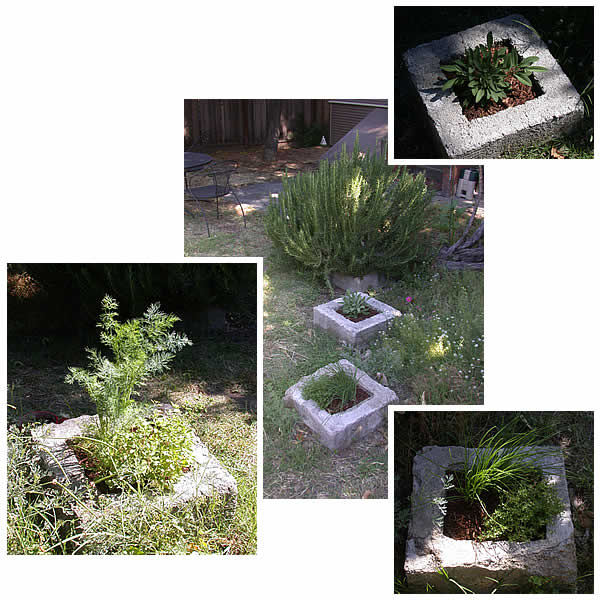
If you don’t have a yard to do this, just grow ‘em in pots on a sunny
windowsill. Rather than write about this though, I found a good link with step-by-step
instructions [click
here to go there]. The only advice I’d add to this
is to make the effort to get organic supplies (potting mix and fertilizer).
Fava, Feta and sundried tomato: I did make this last week, but not as
a sandwich spread (I’d run out of bread!); instead, I used it like a salad,
on top of torn spinach leaves. I just cooked and peeled the fava beans, mashed
them coarsely with a fork, then combined them with diced oil-cured sundried tomatoes
and crumbled feta cheese. Add a little extra olive oil if it seems dry. If you
don’t have the oil-cured kind of dried tomatoes, try this: the day before
you go to use them, put dried tomatoes into a small bowl, pour boiling water
over them, and add a little olive oil and stir. Cool to room temperature, cover
and refrigerate. They’ll plump up nicely!
What I’d do with this week’s box
Everybody always makes pesto with
their first batch of basil. I’m no different!
If you go to my recipe database, you’ll see that’s the first entry
under ‘Basil’ – a posting from back in 1999! I still make it
more or less the same way, except I toast my pine nuts in the toaster oven now,
instead of a dry skillet (and either works fine). The fresh garlic in
the shares will make the pesto particularly nice! I’ll then grill onions, fennel,
mushrooms and summer squash, chop coarsely, and throw into some cooked
penne pasta with the pesto. If you’re a meat eater, grill some chicken
while you’re at it, cut meat into bite-size pieces (save the bones for
making stock!) and toss them in as well. Later in the summer, when we start getting
eggplant and peppers, they’d get grilled and added too! This would be a
good meal to accompany with Caesar salad using the romaine lettuce. See
last
week’s newsletter for my version of Caesar dressing, and below for
my friend Alie’s version. I’d make French Onion Soup again
like I did two weeks ago (it’s dead easy – see recipe below), and
embellish it by adding
tatsoi and carrot to the mix [I’ll talk about this in the
recipe]. When I get broccoli, I love to make Jane
Brody’s broccoli
sardine pasta. My husband Ken devours it! If I have the time I’ll make
a chocolate-beet
cake. Don’t look so aghast – it’s great! No
one but you knows the beets are in there; they just add moisture and richness,
and a certain ‘je ne sais quois.’ We’re getting so many strawberries this
week, I just might have to make strawberry
daiquiris (or agua
fresca for the
kids). They’d go well with the chocolate beet cake! Or with the pesto
pasta!! (Or, just slice up those strawberries and serve 'em right on top of the
chocolate beet cake!) What about those mustard
greens though?
Depending on my mood, I’ll
either do my usual (use as salad greens with lettuce and a fruity dressing
of some sort – see last week’s recipes for salad
dressings), or I might
use them in a simple frittata or
quiche. Too much trouble? Try this then: cook them down [steam until they wilt,
squeeze out excess water, then chop coarsely] and add them to scrambled eggs
(put a little soy sauce into the beaten eggs for salty flavor). Serve with hot
buttered sourdough toast. That’ll kick-start
your morning!
French Onion Soup
from Nourishing Traditions by Sally Fallon [my comments in square brackets as
usual]
serves 6 [just use this recipe as a guide for proportions; it can be easily decreased
or increased to fit your supply of ingredients on hand]
4-5 red onions [I’d use white no problem if we dont’ get red]
4 tbsp. butter
2 quarts [good homemade!] beef stock
½ C cognac [I didn’t have any so I left this out]
½ C red wine
2 tbsp. arrowroot mixed with 2 tbsp. water [not sure what this is for; I left
it out and don’t think the soup was any the worse for wear]
sea salt or fish sauce and pepper
Use your food processor to slice onions very thinly [or a sharp knife works just
as well]. Melt butter in a large, stainless steel pot. Add the onions and cook
on the lowest possible heat, stirring occasionally, for about 2 hours, or until
the onions are very soft and slightly caramelized [I made a smaller batch of
soup myself, and got the onions satisfyingly mooshy and golden in about 30 minutes;
a trick: add a touch of sugar after the first 10 minutes or so and the onions
caramelize a little quicker. But if you have the time, the long, slow cook is
the best way to go]. Raise heat a bit and cook a few minutes longer, stirring
constantly. The onions should turn brown but not burn. Add wine, cognac, and
stock. Bring to a rapid boil and skim off any foam that may rise to the top.
Add the arrowroot mixture [again, I left this out] and season to taste.
[You can serve the soup just plain, like this, or a fun way to go is to make
broiled cheese-toasts and float a slice on top of each bowlful upon serving.
To make cheese-toasts, toast slices of sourdough baguette or similar, then top
with grated gruyere or Swiss cheese or even parmesan or romano, and then pop
into your toaster oven or under a broiler to melt/brown the cheese.]
Onion Soup with tatsoi and carrot
Using the above recipe, I just sliced up fresh carrot and added them when I added
the stock, cooking about 10 minutes to soften the carrots. Then I threw in a
couple handfuls of tatsoi (chopped coarsely if big) and cooked another minute,
until the greens had just wilted.
Alie’s toss-at-the-table Caesar Salad
by member Alie Victorine of San Jose
When I was growing up in Phoenix, my mom and I would go to this great seafood
restaurant called Neptune's Table. It was very 50's and they would make a Cesar
Salad for two right at the table. Well I paid attention every time we ordered
it - which was often! And this is how my adaptation grew. By the way - the origins
of this salad is from Tijauna Mexico.
About half an hour before, smash 2-3 cloves of garlic (leave them whole so you
can easily remove) and marinate in olive oil - I fill a custard cup about 1/3
full. I add the oil from a can of flat anchovies and put in several healthy dashes
of Crystal hot sauce (If you use Tabasco - use several drops). The custard cup
should be about half full for a large head of romaine.
Wash and dry one large head of Romaine [tearing or chopping leaves into bite-size
pieces]; sprinkle with a bit of salt, lots of fresh ground pepper, and 1/4 to
1/2 tsp of sugar.
Grate fresh parmesan cheese (I use 1/2 to one cup depending on my cheese mood)
and dice the anchovies (I will use two cans if the salad is going to be a meal).
Discard the garlic, and pour oil mixture over the greens and toss, toss, toss!
Pour the juice of one lemon over the greens and toss some more. Add cheese, anchovies
and croutons. I use seasoned rather than ‘Caesar style’ croutons,
as the Caesar style are made to go with the creamy style dressing which has a
distinctively different taste than the original. [I personally can’t stand
the creamy-style Caesar dressings... ick! Don’t bother!! - Debbie] Toss
salad again and serve.
[Making your own croutons is dead easy too; cut bread into cubes – I like
to use sourdough, WITH the crust! – toss cubes with olive oil, sprinkle
with salt and maybe some crushed dried herbs, pepper if you like, then spread
out on a rimmed baking sheet and bake in a moderate (350 degrees) oven, shaking
pan once or twice while baking, until lightly browned and crispy, oh, ten, maybe
15 minutes depending on how big you make the cubes. Peek in on them periodically
to see how they’re doing.]
Egg version:
I stopped using egg in my dressing with the scare of salmonella - but am thinking
of trying it again with our great eggs which we get in our share. The egg allows
the lemon and oil flavors to blend. It softens and smoothes out the taste. Prep
everything, but before mixing - coddle one egg (bring water to a low boil and
put an un-shelled egg in for 1- 2 minutes). It shouldn't be cooked at all, but
it should be warmed - the egg white just starting to turn white. [Crack and]
whisk this into the oil and then proceed as before.
Hmm... I think I will experiment with the egg part again and get back to you
if there is anything I am forgetting, as it's been a while! – Alie
<back to top>
Calendar of Events
~~~~~~~~~~~~~~~~~~~~~~~~~~~~~~~~~~~~~~~~~~~~~~~~
(see calendar on website for more info)
<> Fri. May 18, Four Fridays Mataganza Garden Internship (5/18, 5/25, 6/1,
6/8)
<>
Sat. Jun 9 Outstanding in the Field Dinner
<> Sat. Jun 23 Summer Solstice
Celebration
<> July 10-14 Teen Adventure Camp <cancelled>
<> Aug 24-26 Childrens Mini-Camp
<>
Sat. Oct 20 Fall Harvest Celebration
<back to top>
Contact Information
~~~~~~~~~~~~~~~~~~~~~~~~~~~
email the farm: farmers@cruzio.com
email Debbie with newsletter input or recipes: deb@writerguy.com
phone: 831.763.2448
web: http://www.liveearthfarm.net
~~~~~~~~~~~~~~~~~~~~~~~~~~~